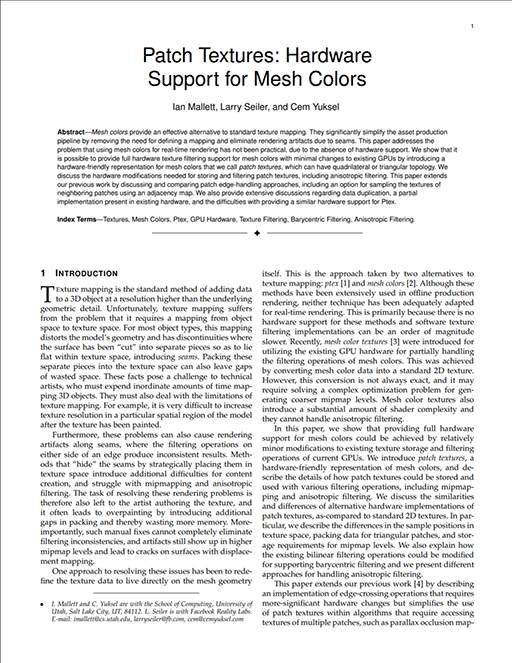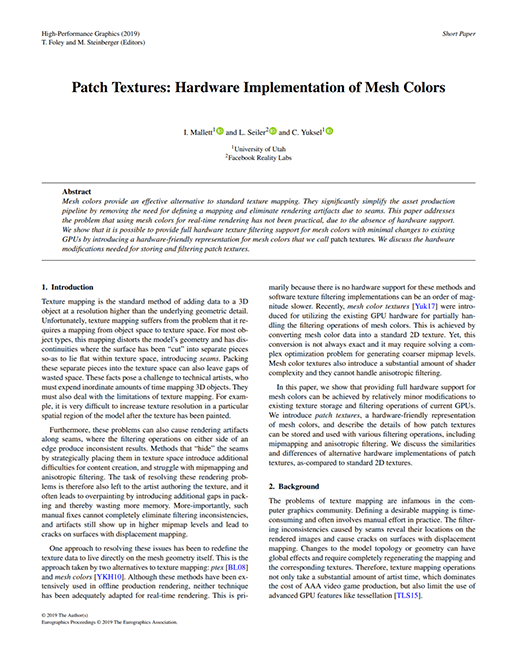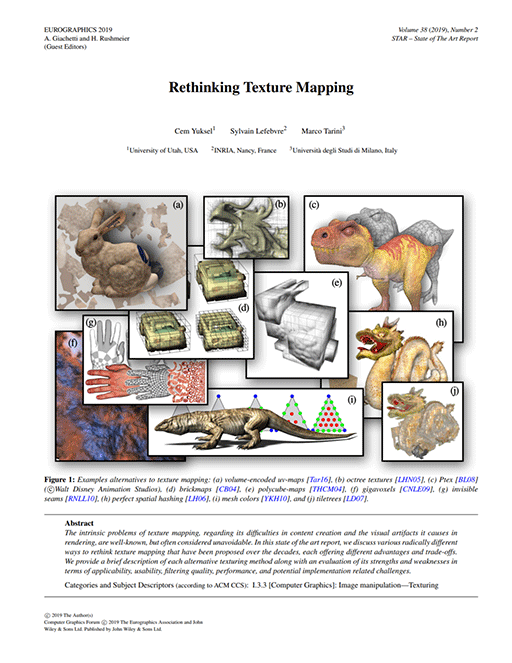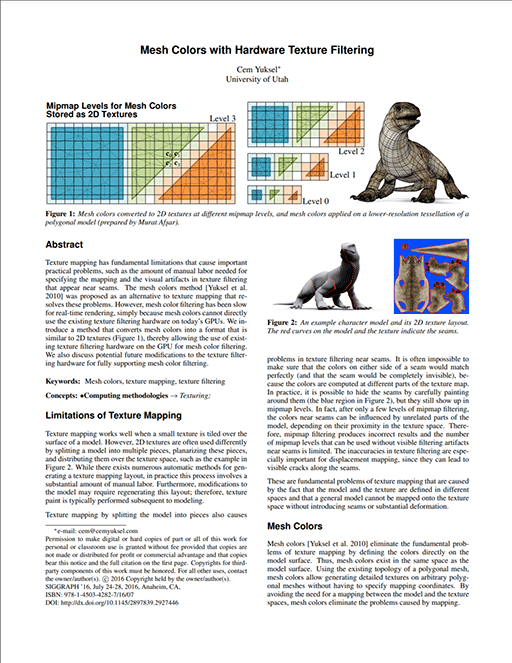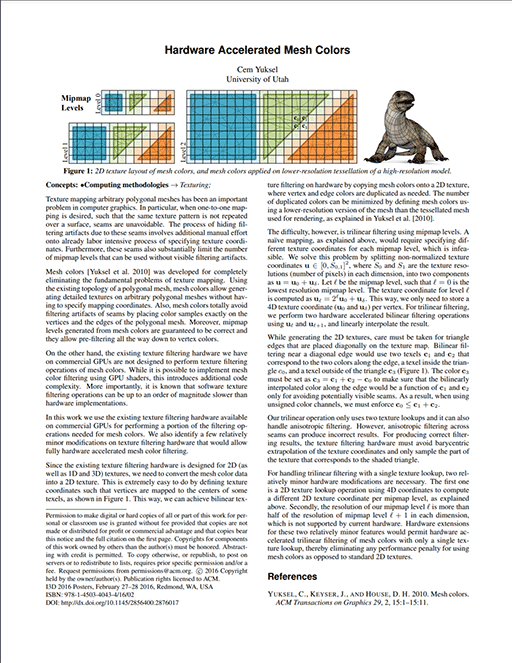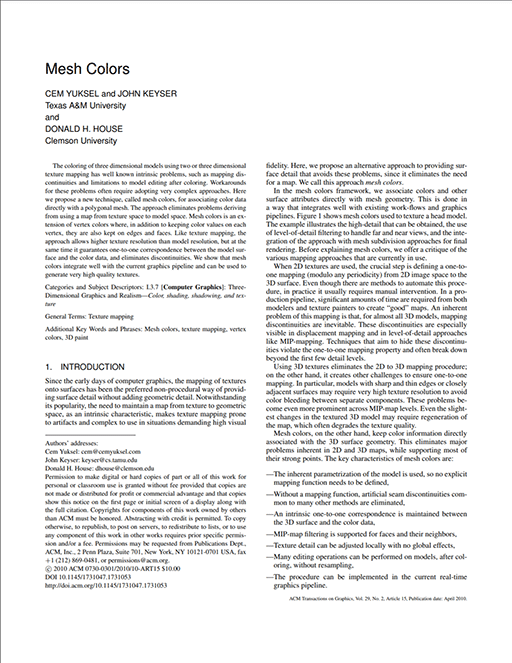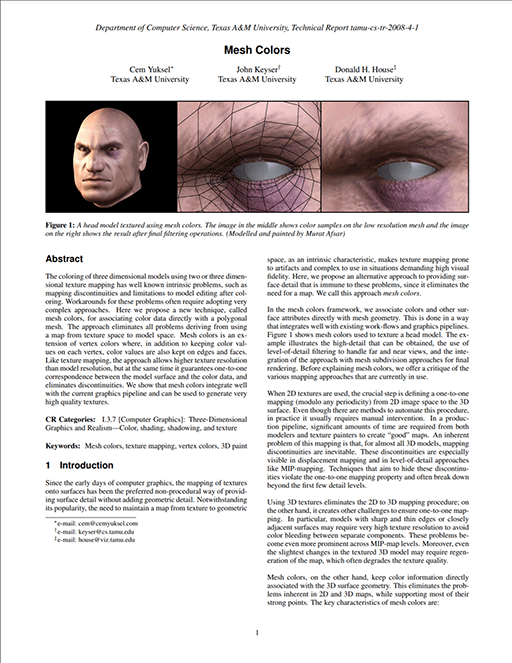SIGGRAPH 2017 Course Notes
Rethinking Texture Mapping

Examples alternatives to texture mapping: (a) volume-encoded uv-maps [Tarini 2016], (b) octree textures [Lefebvre et al. 2005], (c) p-tex [Burley and Lacewell 2008] (© Disney Animation Studios), (d) brickmaps [Christensen and Batali 2004], (e) polycube-maps [Tarini et al. 2004], (f) gigavoxels [Crassin et al. 2009], (g) invisible seams [Ray et al. 2010], (h) perfect spatial hashing [Lefebvre and Hoppe 2006], (i) mesh colors [Yuksel et al. 2010], and (j) tile-trees [Lefebvre and Dachsbacher 2007].
Course Description
Texture mapping is fundamental to much of computer graphics but has a number of fundamental issues. Creating uv-maps is time consuming and involves extensive manual effort. Distortions and seams introduced by mapping complicate texture authoring, filtering, and procedural synthesis. The final result is optimized for a specific mesh, and it does not necessarily work through LODs. Any change to the geometry implies updating uv-maps and textures. Texturing other surface representations (implicit surfaces, point clouds) requires a conversion to a mesh. As a consequence, texture mapping continues to occupy a substantial portion of artist time, which dominates the cost of world-class video game production.
Since the early days of texturing, research has focused on how to alleviate or even bypass traditional texture-mapping limitations. Unfortunately, the ubiquitous adoption of texture mapping implies that it is seldom questioned as the method of choice, and authoring pipelines and rendering engines have been shaped around its intrinsic limitations, thereby making it harder for alternatives to appear.
Recently, the industry has recognized the advantages of alternative texture-mapping methods such as the increasingly popular P-Tex method. Several advances in GPU technologies have made alternative texturing approaches computationally very efficient, and the industry has shown a renewed interest in moving beyond texture mapping. And the algorithms and data structures used by some alternative approaches extend beyond texturing, toward solid modeling, volume rendering, and simulations on surfaces.
This course summarizes alternative approaches and their advantages and tradeoffs regarding ease of authoring, storage, versatility, rendering quality, and speed.
Presenters
Marco Tarini (PhD, Pisa, 2003) is an associate professor at the Università dell'Insubria, Varese, Italy and an a Associate Researcher with CNR-ISTI, Pisa, Italy. His research interests span Computer Graphics and its applications. He is active in areas like real-time rendering (including texture mapping, texture representations techniques), geometric modelling, visualization, digital fabrication, and video game development. He co-authored several works in all top journals and conferences, including many award winning papers and highly cited ones. Marie Curie fellow, he serves as an IPC member in the main conferences of the field. In 2006, he was granted the Young Researcher Award by Eurographics.
Cem Yuksel is an assistant professor in the School of Computing at the University of Utah and the founder of Cyber Radiance LLC, a computer graphics software company. Previously, he was a postdoctoral fellow at Cornell University after receiving his PhD degree in Computer Science from Texas A&M University. His research interests are in computer graphics and related fields, including physically-based simulations, realistic image synthesis, rendering techniques, global illumination, sampling, GPU algorithms, graphics hardware, modeling complex geometries, knitted structures, and hair modeling, animation, and rendering.
Sylvain Lefebvre is researcher at Inria since 2006. His main research focus is to simplify content creation, synthesizing highly detailed patterns, structures and shapes, with applications in Computer Graphics and additive manufacturing (3D printing). In 2010, he was honored with the EUROGRAPHICS Young Researcher Award for his work on texturing data structures and runtime procedural texture synthesis. Since 2012, he is the principal investigator of the ERC ShapeForge project, which focuses on shape synthesis for additive manufacturing. Sylvain is an active member of the community, and serves on the technical papers committee of the main conferences of the field.
Course Video
Course Notes
Complete Course Notes [PDF] - 31.2MB
-
Introduction
- Invisible Seams
- Seamless Toroidal/Cylindrical Textures
- Seamless Texture Atlases
- Ptex
- Mesh Colors
- Mesh Color Textures
- Adaptive Texture Maps
- Octree Textures, Brickmaps, N3 Trees, and Gigavoxels
- Perfect Spatial Hashing
- TileTrees
- PolyCube Maps
- Volume-encoded UV-maps
Presenter: Cem Yuksel Perfecting Traditional UV-maps
Presenters: Marco Tarini and Cem Yuksel
Presenter: Cem Yuksel
Presenter: Cem Yuksel
Presenter: Marco Tarini
Presenter: Marco Tarini and Cem Yuksel

